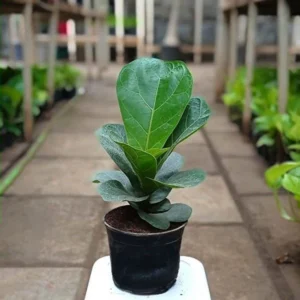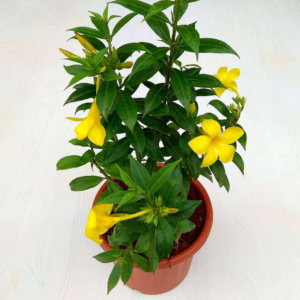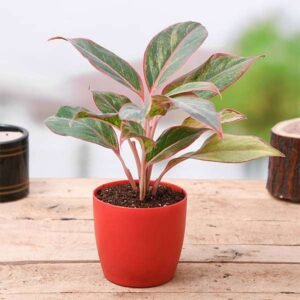Description
MONEY PLANT (SILVER PLANT) – A COMPLETE DESCRIPTION
The Money Plant, often referred to as the Silver Plant, is one of the most beloved and widely cultivated houseplants around the world. Scientifically known as Epipremnum aureum, this hardy, versatile vine is admired not only for its attractive foliage and low-maintenance nature but also for its cultural symbolism of prosperity, wealth, and good luck. While “Money Plant” is a name shared by a few different species depending on the region (including Pachira aquatica and Crassula ovata), the variety typically called the “Silver Plant” refers to a variant of Scindapsus pictus, a close relative of Epipremnum aureum, known for its silver-spotted or variegated leaves.
Botanical Classification
- Common Names: Money Plant, Silver Vine, Silver Pothos, Devil’s Ivy, Satin Pothos, Scindapsus
- Scientific Name: Scindapsus pictus (Silver variant), Epipremnum aureum
- Family: Araceae
- Origin: Native to Southeast Asia, particularly the Solomon Islands and parts of Indonesia
Physical Description
The Silver Money Plant is a trailing vine known for its striking, heart-shaped leaves with splashes or speckles of silvery-white variegation. The leaves are smooth, thick, and velvety to the touch, giving the plant an elegant appearance. These silver markings reflect light beautifully, making the plant a popular choice for indoor decoration and vertical gardening.
Mature vines can trail several feet, making them ideal for hanging baskets, trellises, or wall mounts. Though the plant rarely flowers indoors, in the wild or in ideal greenhouse conditions, it can produce small, spadix-type flowers surrounded by a spathe—typical of the Araceae family.
Growing Conditions and Care
Light Requirements
Money Plants prefer bright, indirect light. They can tolerate lower light conditions, which makes them suitable for indoor environments like offices and bedrooms. However, excessive direct sunlight can scorch their leaves, while too little light can reduce variegation and growth.
Watering
This plant enjoys moderate watering. The soil should be kept slightly moist but not waterlogged. Overwatering can lead to root rot, a common issue among indoor plants. A good rule of thumb is to water the plant when the top inch of soil feels dry.
Soil
A well-draining potting mix is essential. A mix designed for indoor plants or made from peat moss, perlite, and compost works well. Ensure that the pot has drainage holes to avoid water accumulation.
Humidity and Temperature
Money Plants thrive in moderate to high humidity and prefer temperatures between 18°C to 30°C (65°F to 86°F). They do not tolerate frost and should be kept away from cold drafts or air conditioning vents.
Fertilization
Use a balanced, water-soluble fertilizer every 4–6 weeks during the growing season (spring and summer). Reduce feeding in winter when the plant’s growth slows down.
Pruning and Maintenance
Regular pruning helps to control the shape and encourages bushier growth. Trimming dead or yellowing leaves also keeps the plant healthy. The cuttings can be used for propagation, which is very simple and rewarding.
Propagation
Money Plants are one of the easiest plants to propagate. The most common method is via stem cuttings:
- Cut a healthy vine below a node (the point where leaves emerge).
- Place the cutting in water or moist soil.
- Roots typically develop within 1–2 weeks.
- Once rooted, transplant the cutting into a pot with soil.
Propagation is not only fun but also a cost-effective way to expand your indoor plant collection or share plants with friends.
Symbolism and Cultural Significance
Across many cultures, especially in Asia, the Money Plant is considered a symbol of wealth, prosperity, and good fortune. In Feng Shui, placing a Money Plant in the southeast corner of a home or office is believed to attract financial success and reduce negative energy. It is also believed to promote harmony, peace, and positive relationships.
The heart-shaped leaves symbolize love and harmony, while the plant’s trailing growth is seen as a representation of upward progress and flourishing finances.
Common Varieties of Silver Money Plants
While the general Money Plant refers to Epipremnum aureum, the “Silver Plant” label typically applies to certain varieties of Scindapsus pictus. Some popular types include:
- Scindapsus pictus ‘Argyraeus’: This variety has dark green leaves with silvery speckles and a shimmering sheen.
- Scindapsus pictus ‘Exotica’: Known for its larger leaves and bold silver blotches.
- Scindapsus pictus ‘Silvery Ann’: Features softer silver patterns with a velvety texture.
Each variety has slightly different appearances but similar care requirements.
Benefits of Keeping a Money Plant Indoors
1. Air Purification
Money Plants are known to purify indoor air. According to NASA’s Clean Air Study, pothos-like plants help remove common toxins such as formaldehyde, benzene, and xylene from the air.
2. Aesthetic Appeal
Their cascading vines and patterned foliage make them an excellent decorative plant, whether in hanging baskets, tabletop containers, or wall-mounted planters.
3. Stress Reduction
Studies suggest that having greenery indoors can help reduce stress, improve focus, and boost overall mood. The Money Plant, with its calm green tones, is particularly effective in creating a soothing environment.
4. Easy to Grow
Their low-maintenance nature makes them ideal for beginners or people with busy schedules. They can thrive with minimal attention and recover quickly from occasional neglect.
Common Problems and Solutions
- Yellowing Leaves: Often due to overwatering or poor drainage. Allow soil to dry slightly before watering again.
- Brown Leaf Tips: Usually a result of low humidity or excessive sunlight. Increase humidity or move to a shadier spot.
- Leggy Growth: Indicates insufficient light. Move the plant to a brighter location or trim the long vines.
- Pests: May occasionally attract pests like spider mites, mealybugs, or aphids. Use neem oil or insecticidal soap to treat infestations.
Final Thoughts
The Money Plant, especially the silver-leafed Scindapsus pictus, combines beauty, symbolism, and resilience into one easy-to-grow plant. Whether you’re looking to add a decorative touch to your living space, purify the air, or bring in good fortune according to cultural beliefs, this plant is an ideal choice. Its adaptability to various conditions and attractive appearance make it a favorite among plant lovers worldwide.
No matter where it’s placed, the Silver Money Plant continues to be a living emblem of growth, balance, and abundance—a true treasure for every indoor garden.







Reviews
There are no reviews yet.